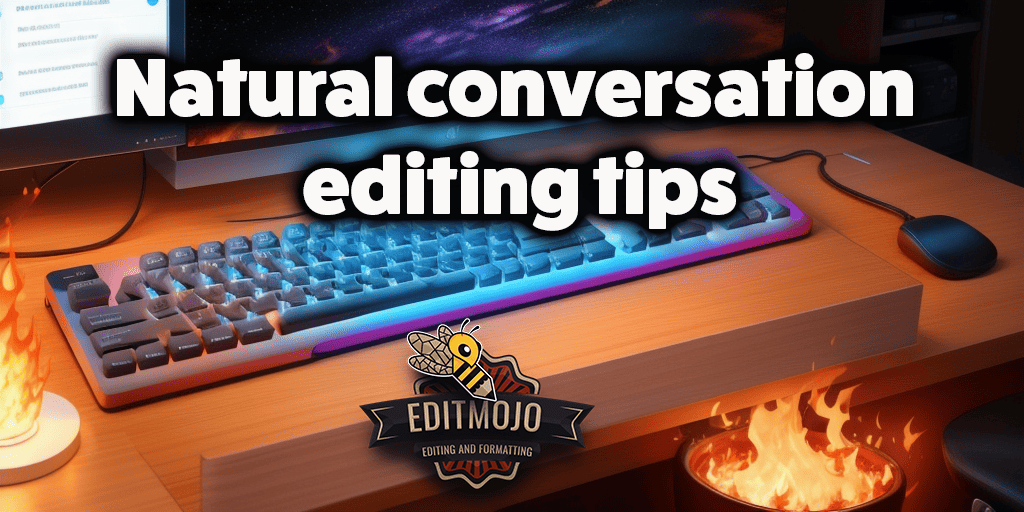Natural Conversation Editing Tips
Natural conversation editing tips. Welcome to the world of editing, where the written word is finely tuned and polished to perfection. When editing natural conversations in written form, the challenge is to make it sound authentic while maintaining clarity and coherence. Here’s your comprehensive guide to natural conversation editing tips.
1. Keep it Real
To begin with, we must recognize that natural conversation is not always grammatically perfect. In fact, it’s often filled with pauses, slang, and colloquialisms. To maintain authenticity, allow some of these elements to filter through into your writing. Just remember, the key is balance. Overdoing it can make the dialogue difficult to read and understand.

2. Use Appropriate Diction
The choice of words can make or break a conversation. Hence, when editing, pay attention to diction. It should reflect the character’s age, background, education, and personality. Writing resources are available to help you master this art.
3. Break Up Text with Action
In natural conversation, people don’t just stand and talk. They gesture, express emotions, and react. Including these actions can bring life to your dialogue. A nod here, a sigh there, can add depth to the conversation, making it feel real.
4. Maintain Consistency
One overlooked aspect of editing conversations is consistency. Each character should have a unique voice that remains consistent throughout the text. This can be achieved by being mindful of their speech patterns, vocabulary, and tone.
5. Use Dialogue Tags Sparingly
While ‘he said’ and ‘she said’ are necessary to keep track of who’s speaking, overuse can make the text monotonous. Try using action beats instead. For example, instead of “‘I’m fine,’ he said,” you can write, “He shrugged. ‘I’m fine.’“

6. Avoid Information Dumps
Real conversations don’t sound like encyclopedia entries. So, refrain from using dialogue as a way to convey large amounts of information. Spread it out or find creative ways to include it in the narrative.
7. Read Aloud
This is perhaps the most effective tip. Reading the dialogue aloud can help identify awkward phrasing and unnatural speech patterns. Tools like NaturalReaders can be used for this purpose.
8. Get Feedback
Last but not least, get feedback from others. They can provide valuable insights that you might have overlooked. Join writing communities or hire a professional editor if necessary.
Editing natural conversation is both an art and a science. It requires an understanding of language, character development, and a touch of creativity. With these tips in mind, you’ll be well on your way to crafting engaging and authentic dialogue.
Remember, practice makes perfect. So, keep writing, keep editing, and most importantly, keep learning.
For more writing and editing resources, check out this comprehensive list. Happy editing!
Deep Dive: Mastering the Art of Natural Conversation Editing
Now that we’ve covered the basics, let’s delve deeper into the realm of editing natural conversation. This is where you can truly elevate your writing from good to great.
1. Understanding Subtext
In real life, what we say often carries more meaning than the words themselves. This is known as subtext. For instance, a character saying, “I’m fine” might actually mean “I’m not okay, but I don’t want to talk about it.” Subtext can add richness and depth to your dialogue, making it more nuanced and intriguing.
2. The Art of Interruption
People often interrupt each other in conversation, especially during heated discussions. Reflecting this in your writing can make it more dynamic and realistic. However, use it sparingly to prevent the dialogue from becoming chaotic and hard to follow.

3. Power of Silence
Silence can be as powerful as words. A pause in a conversation can convey tension, uncertainty, or contemplation. This can be represented in your writing through ellipses (…), a separate paragraph describing the silence, or through the characters’ actions during the silence.
4. Punctuation is Key
Punctuation can significantly impact the tone and pace of a conversation. Commas can create a pause, exclamation marks can show excitement or shock, and question marks obviously denote a question. Use punctuation wisely to infuse emotion and rhythm into your dialogue.
5. Regional Accents and Dialects
If your characters are from specific regions or countries, incorporating their accent and dialect can make your conversation more authentic. Be careful, though. Overdoing it can make the dialogue hard to read. Also, it’s crucial to avoid stereotyping or offending anyone.
6. Non-Verbal Communication
A large part of communication is non-verbal. Expressions, body language, and even the environment can impact a conversation. Describing these elements can make your dialogue more vivid and immersive. For example, a character nervously tapping their foot under the table can indicate their discomfort or impatience.
7. Editing Tools
Lastly, don’t shy away from using editing tools. Tools like Grammarly or ProWritingAid can help you with grammar, punctuation, and style, allowing you to focus on the finer nuances of dialogue editing.
In Conclusion
Editing natural conversation is not just about fixing grammar and punctuation. It’s about capturing the essence of human interaction and portraying it in a way that engages the reader. It might seem daunting at first, but with practice and dedication, you’ll find your unique style and rhythm.
Stay tuned for more in-depth articles on writing and editing. Remember, every writer has a unique voice. It’s all about finding yours. Happy editing!
